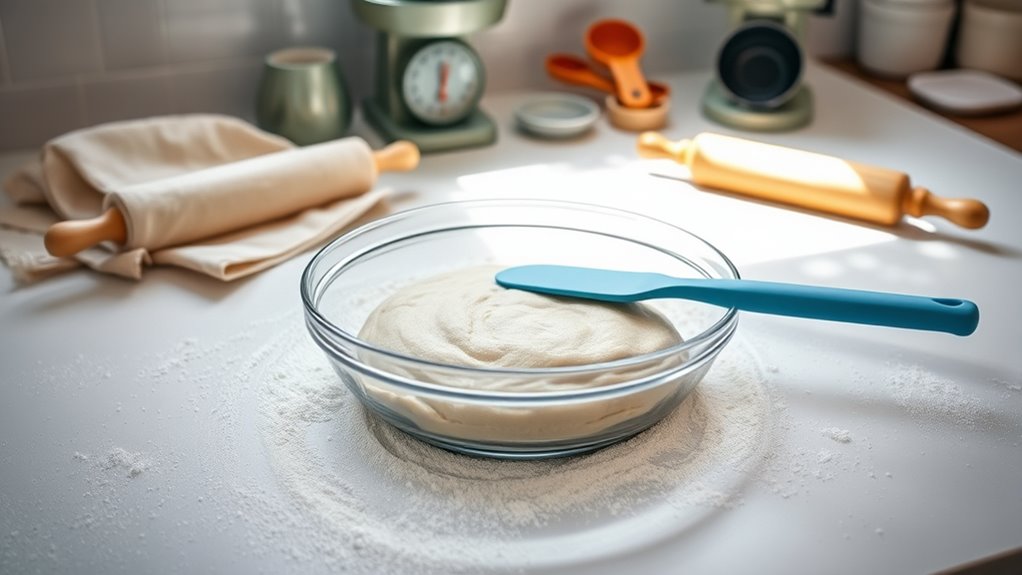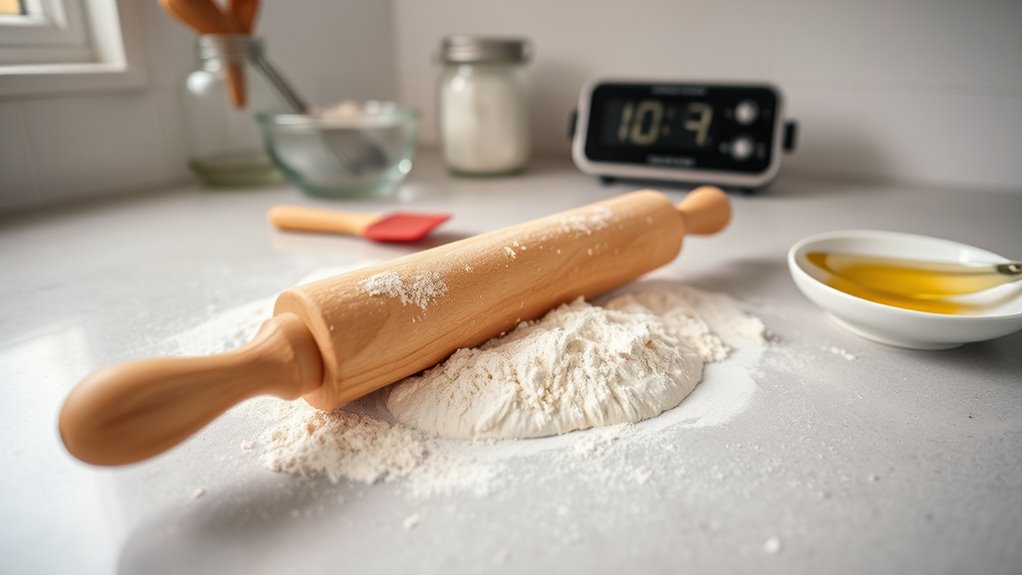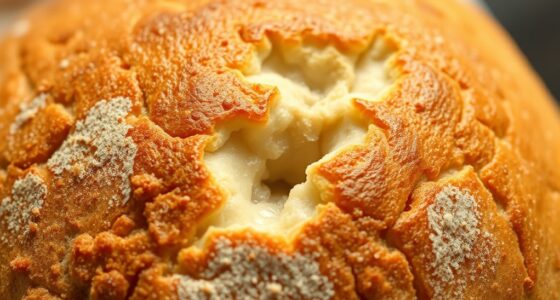Before you start, make certain your work surface is clean and flat, then lightly dust it with a flour alternative like cornstarch or rice flour, or spray it with a non-stick spray for an even barrier. Keep a small spray bottle nearby to reapply as needed, and chill sticky dough to make handling easier. Always handle dough gently and reapply dust or spray if sticking starts. Want to master these tips and more? Keep going to learn how!
Key Takeaways
- Ensure your work surface is clean and lightly dusted with flour alternative or sprayed with non-stick spray.
- Chill sticky dough in the refrigerator for 15-20 minutes to improve handling and reduce sticking.
- Lightly coat your rolling pin and tools with non-stick spray or flour alternative before use.
- Reapply flour alternative or spray as needed during rolling to maintain a non-stick surface.
- Handle dough gently and stop to reapply dusting or spray if sticking begins to occur.
Essential Tips to Prevent Dough Sticking

Dealing with dough sticking can be frustrating, but having a reliable checklist can make the process much easier. Before you start, it’s essential to prepare your workspace and gather the right tools. One of the most effective ways to prevent sticking is to consider flour alternatives. Traditional flour is common, but it can sometimes make dough dry or alter its texture. Instead, you might opt for cornstarch, rice flour, or potato starch, which can reduce sticking without compromising the dough’s consistency. These alternatives often work better on sticky or delicate doughs, especially when working with gluten-free recipes.
Next, make sure you have non-stick sprays on hand. These sprays create a barrier between your dough and your work surface or rolling pin, considerably decreasing the chances of sticking. Lightly coating your rolling pin and work surface with a non-stick spray can make a noticeable difference, especially for sticky doughs that tend to cling. Just be careful not to overapply, as excess spray can sometimes cause a greasy texture or an uneven surface. Using a light, even coating ensures smooth rolling and handling, saving you time and frustration.
Another key step is to prepare your work surface properly. Clear a clean, flat space, and lightly dust it with your chosen flour alternative or non-stick spray. This creates a barrier that prevents the dough from sticking while you work. If your dough is particularly sticky, consider chilling it in the refrigerator for about 15-20 minutes before rolling. Cold dough is often easier to handle and less prone to sticking, especially when working with high-humidity environments or very soft doughs.
It’s also wise to keep a small bowl of your flour alternative or a spray bottle nearby for quick touch-ups. As you roll out or manipulate the dough, you can lightly dust or spray more as needed. This approach helps maintain a manageable stickiness level without over-flouring, which can toughen the dough or alter its texture. Remember, consistency is key—apply just enough to keep things moving smoothly.
Finally, remember that patience and gentle handling are vital. If you notice the dough starting to stick, stop and adjust your approach by adding a little more flour alternative or spraying again. A reliable checklist that includes these steps—using flour alternatives, non-stick sprays, proper surface prep, chilling, and gentle handling—can save you from the common pitfalls of dough sticking. Incorporating effective preparation techniques can further improve your baking experience and ensure smoother results. With these tools and techniques, you’ll find baking or rolling out dough becomes a more straightforward, less stressful process.
Frequently Asked Questions
What Are the Best Types of Flour to Prevent Dough Sticking?
You should use flours with different textures and gluten contents to prevent dough sticking. All-purpose flour works well because it has moderate gluten, providing structure without being sticky. Bread flour, with higher gluten, offers extra strength, reducing sticking. Avoid very soft flours like cake flour, which have low gluten. By choosing the right flour with suitable textures and gluten levels, you’ll keep your dough manageable and prevent sticking effectively.
Can Refrigeration Help Reduce Dough Sticking Issues?
Refrigeration benefits your dough by firming it up, making it less sticky and easier to handle. Chilling improves dough consistency, preventing sticking during rolling or shaping. When you refrigerate, you give the gluten structure time to relax, which enhances texture and elasticity. So, yes, refrigeration can markedly reduce dough sticking issues, helping you achieve smoother, more manageable dough every time. Just remember to cover it to prevent drying out.
Does the Type of Baking Surface Affect Dough Sticking?
Yes, the type of baking surface affects dough sticking. Non-stick coatings and silicone mats are excellent options because they prevent dough from adhering without extra flour or oil. Silicone mats, in particular, offer a smooth, reusable surface that makes handling dough easier and cleanup quicker. Using these surfaces guarantees your dough slides off effortlessly, helping you achieve perfect results every time while reducing the risk of sticking-related frustrations.
How Does Humidity Impact Dough Sticking?
Humidity effects can turn your dough into a sticky mess, like a clingy lover refusing to let go. When moisture levels rise, your dough absorbs the damp air, making it stickier and harder to handle. To fight this, practice moisture control by dusting your surface with flour or adjusting ingredients to counteract humidity effects. Keep the environment cool and dry for smoother, less clingy dough that’s easier to work with.
Are There Alternative Ingredients That Prevent Dough From Sticking?
Yes, you can use alternative ingredients to prevent dough from sticking. Applying an egg wash creates a barrier that reduces sticking, especially for pastries. Non-stick spray is another effective option; simply spray your surface or dough lightly. You might also dust your work surface with flour or cornstarch, but be cautious not to add too much, as it can alter texture. These methods help keep your dough manageable and prevent sticking during preparation.
Conclusion
Now that you’ve got the essential tips, you’re almost ready to conquer any dough disaster. But remember, even the best techniques can surprise you. Will your next batch stick or slide perfectly? Keep these secrets in mind, stay attentive, and stay tuned—because the unexpected can happen when you least expect it. Are you prepared to master your dough and unseal flawless creations every time? The secret’s just a step away—are you ready to find out?









